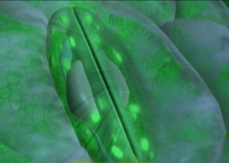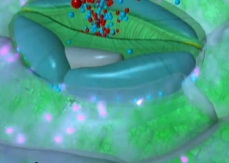Transcription of video clip One day at a time
Opening and closing of stomata
How do leaves decide exactly when to open or close their stomata, whether it is day or night?

© Dr. Lawrence Jensen
In bright green, the chloroplasts
Two elongated guard cells surround the stomata.
The chloroplasts in these cells absorb sunlight thanks to the chlorophyll they contain.
At sunrise, potassium ions from neighbouring cells invade the guard cells.
The potassium ions build up in the structures called vacuoles.
Water, which tries to dilute this concentrated potassium, follows the ions by osmosis.
The vacuoles fill up with water, and expand like balloons.
They press against the cell wall of the guard cell.
The guard cell cannot expand because it is held tight in its cellulose ring.
It cannot lengthen, either, because it is tied to its neighbour.
With the increasing pressure, the guard cells expand outward and bow apart from each other.
A space appears between them: the stoma, which allows air to circulate.

© Dr. Lawrence Jensen
In pink, the potassium ions
At the end of the day, the sun sets and the process is reversed.
The potassium ions, followed by water, leave the guard cells.
The vacuoles deflate and the guard cells regain their initial shape.
The stoma disappears until the next morning. This way, the cell doesn't transpire unnecessarily at night, when the absence of light prevents photosynthesis.
Back to video clip




